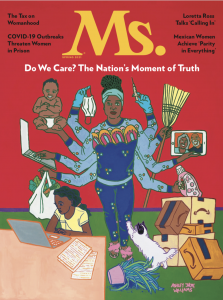Our current caregiving crisis is the inevitable outcome of an outdated ideology that has resulted in insufficient investments in our care infrastructure and in our people.
The COVID-19 pandemic “is the most discriminatory crisis we [women and girls] have ever experienced,” Phumzile Mlambo-Ngcuka, executive director of U.N. Women, said at the opening of the 65th Commission on the Status of Women in early March.
Her statement rings just as true in the U.S. as elsewhere in the world. Since the start of the pandemic a little more than a year ago, American women have lost a net total of 5.4 million jobs—1 million more than men—and by the end of February nearly 3 million women had left the workforce entirely, many of them to care for their families.
Our current caregiving crisis is the inevitable outcome of an outdated ideology that has resulted in insufficient investments in our care infrastructure and in our people. This has put the essential, yet deeply undervalued, task of caring for our young, elderly, sick and disabled family and community members onto individuals—when this can, and must be, a shared priority for all of us, and, therefore, a responsibility of our government.
A Country With a History of Devaluing Care Work
We didn’t get here by accident. The pandemic has revealed the myriad ways that our economy is not set up to support and empower women, and the caregiving crisis we are experiencing is the result of long-standing policy choices. Ultimately, an economy that does not work for women is a liability for our collective economic health.
Since the founding of this country, caregiving labor provided by women, especially immigrant women and women of color, has been seen as simultaneously essential and lacking inherent value. It is not a coincidence that, along with other marginalized groups whose livelihoods and lives are not valued, women of color have always been disadvantaged and disregarded in our society.
The undervaluation of caregiving labor and the people who perform it has persisted well into modern times, and the underlying sexism and racism that underpin such cultural norms—rooted in the legacy of slavery and Jim Crow—have made it harder to develop a robust caregiving infrastructure over the decades.

This article originally appears in the Spring 2021 issue of Ms. Become a member today to read more reporting like this in print and through our app.
The devaluing of domestic work is deeply rooted in racism, as agricultural and domestic workers were deliberately left out of the National Labor Relations Act of 1935 as a concession to racist white lawmakers—with the knowledge that these were jobs held by Black workers.
The conservative framing of care as an individual’s responsibility and part of what it means to pull yourself “up by your bootstraps” suggests that the lack of a caregiving infrastructure does not have systemic implications. This idea that caring for the young, sick, disabled and elderly is the responsibility of the family—and in particular, women—is part of a much broader cultural argument conservatives have been making ever since “traditional” gender norms started to change, and, unfortunately, it’s one that persists today.
Fifty years ago, the feminist movement came within a stone’s throw of a universal child care system. The Comprehensive Child Development Act, which passed with a bipartisan vote in Congress, would have established thousands of federally funded child care centers. Such a program would have been transformative: Then-Sen. Walter Mondale (D-Minn.), one of the bill’s cosponsors, saw the program as a first step toward establishing universal child care, its affordable and expansive approach destigmatizing government provision of care.
That dream died, however, when the bill reached President Richard Nixon’s desk. He cited fears that such a program would “commit the vast moral authority of the National Government to the side of communal approaches to child rearing over against the family-centered approach.” (Nixon speechwriter Pat Buchanan urged him to frame it as “the Sovietization” of childhood.)
The argument that paid caregiving work is not worthy of public support has left the child care providers, with their slim profit margins, grossly underfunded and often inaccessible to families. Pre-pandemic, more than half of Americans were living in “child care deserts,” in both rural and urban areas where care providers are impossible or very difficult to find, according to a 2018 report by the Center for American Progress.
Without support for child care infrastructure, U.S. families are forced to navigate caregiving largely on their own—and the care workforce remains stuck earning poverty-level wages. Pre-pandemic, the 1,146,400 members of the formal child care workforce earned a median hourly wage of $11.65 per hour and were almost entirely women (95 percent)—disproportionately women of color. One in five child care workers are Latinas, and 19 percent are Black women, though they make up less than 8 percent and 7 percent of the U.S. workforce, respectively.
The workforce in residential care (74 percent women, 43 percent people of color) and home health care (88 percent women, 53 percent people of color) totaled 3.4 million in 2019. Unsurprisingly, median wages were low: $12.36 for home health care workers and $12.15 for residential care workers—barely an annual income of $25,000.
A Breaking Point for Women
The COVID-19 pandemic has made it more evident than ever that women, especially Black women and Latinas, are trapped in an economy that is set up to extract their labor without paying them their due—all while also relying on them to solve the caregiving needs of their families on their own.
Millions of women, particularly low-income women, were pushed from the labor force by business closures and cutbacks, or they were driven to leave jobs or reduce their work hours when child care centers and schools closed, or, lacking paid leave, when they or their family members became sick.
A year on, women’s labor force participation is down 2 percentage points, with nearly 275,000 women leaving the labor force in January 2021 alone; the crisis is far worse for Black and Asian women, as well as Latinas, all of whose employment levels remain far below those of white women.
A recent survey from the National Employment Law Center, Color of Change, the Cornell Worker Institute and Time’s Up Foundation suggests that the sudden need to provide care is playing a major role in keeping women out of the paid labor force: More than half of Latinas surveyed and 44 percent of Black women said that unpaid caregiving responsibilities would negatively affect the amount of paid work they would be able to take on going forward. And there’s no end in sight: Nearly half of all child care centers could close permanently as a result of the pandemic, and the flight from nursing homes has left many women caring for older relatives.
As the pandemic subsides, we must address this deep economic upheaval, which is resulting in an estimated $64.5 billion per year in lost wages for mothers alone. As a central component of our response, we must confront the total collapse of America’s patchwork care infrastructure.
It’s time for the nation to act on a fundamental truth: Our economy and society are stronger when all people can live lives of stability and dignity.
KEEP READING:
Part 2: The Nation’s Moment of Truth: The Economic and Moral Case for Investing in Caregivers
Up next:





